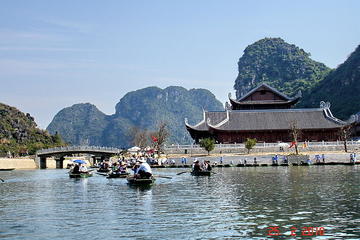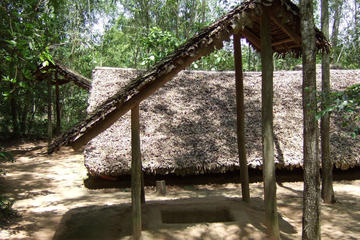Halong and Lan Ha Bay are two outstanding gems of Vietnam’s tourism with similar scenery of limestone islands on the emerald sea. These are great options for a one-day cruise; however, many travelers wonder which one of them is suitable for their 1-night trip. This article will provide useful insights to help you make your decision easily and quickly.
The main differences between Halong Bay & Lan Ha Cruise
Despite cruising through pretty similar landscapes, the experience for 2-day-1-night cruises differs in each bay.
Itinerary
Halong Bay cruises typically follow a common route of Titop Island – Luon Cave – Sung Sot Cave. The itinerary often includes swimming and water activities in Titop, kayaking or bamboo boating to pass through Luon Cave as well as walking to explore Sung Sot Cave. Additionally, most locations in Ha Long have been well-known and utilized for sightseeing tourism for a long time, so the infrastructure is modern. For instance, Indochine Cruise Halong Bay offers luxury amenities and classic route to the best highlights of the bay.
In contrast, Lan Ha Bay Cruise stands out with a wealth of exploration spots, including landmarks less visited by tourists. The cruise ships here mostly include Dark & Bright Cave and Tra Bau Area in the schedule. However, besides the popular route through common tourist spots, some cruises here also offer tours to more unique destinations, Ginger Cruise Halong Bay with Viet Hai Village on Cat Ba Island and Frog Pond during its 1-night cruise.
Type of cruise
Since the tourism industry in Ha Long is older and more developed with a huge volume of tourists every year, Halong Bay Cruise focuses on medium to large-capacity boats over 20 cabins, catering well to a large number of guests. The predominant style here is traditional Vietnamese, but there are also a few boats with a modern style to meet the diverse needs of travelers.
Cruises in Lan Ha Bay are notable for their variety of boat types, ranging from small boats with only 10 cabins to larger ones with over 30 cabins. As a trending tourist destination in recent years, Lan Ha Bay has received more investment and attention, resulting in most of the boats being newly launched or recently operated. Each boat has its own unique character to cater to different groups of guests, from distinctive boutique boats to luxurious, modern yachts like the Doris Cruise Ha Long Bay.
Departure port
There are two main harbors for arriving and departing tourist ships: Halong International Harbor, located near the city center of Ha Long, and Tuan Chau Marina, situated in Tuan Chau, 12.5 km from Ha Long City. While tourists can embark on Halong Bay cruise ships right at the port, Lan Ha Bay cruise ships usually moor in the middle of the bay, taking around a 25-minute tender transfer from the port. This makes accessing Halong Bay cruises a bit easier than Lan Ha Bay cruises.
Which cruise will be suitable for your 1-night trip?
Halong Bay Cruise is suitable for first-time visitors to Vietnam who want to explore famous destinations that are the icons of the bay. Here, tourists will participate in interesting activities with a more energetic vibe of a lively tourist destination. With a variety of large-capacity boats, the cruise here offers spacious and comfortable environments, making it ideal for families and large groups of friends.
Meanwhile, Lan Ha Bay Cruise caters to couples, older adults, and smaller groups who prefer a more unique and peaceful travel experience. The activities at the attractions in the cruise itineraries here are similar to those of Halong Bay Cruise, such as kayaking, swimming, and sightseeing; however, it is more tranquil and closer to nature. With elegantly designed services, the cruise offers a gentle and intimate journey, allowing travelers to fully enjoy relaxation.
Cruises in both Halong Bay and Lan Ha Bay offer travelers unique and captivating experiences, each with its own charm. Depending on your preferences and budget, you can choose the most suitable trip to enjoy the natural wonders of Vietnam. To learn more about the cruises around these bays, contact BestPrice Travel, the most reputable tour provider in Viet Nam to have the best support.
BestPrice Travel Vietnam
|
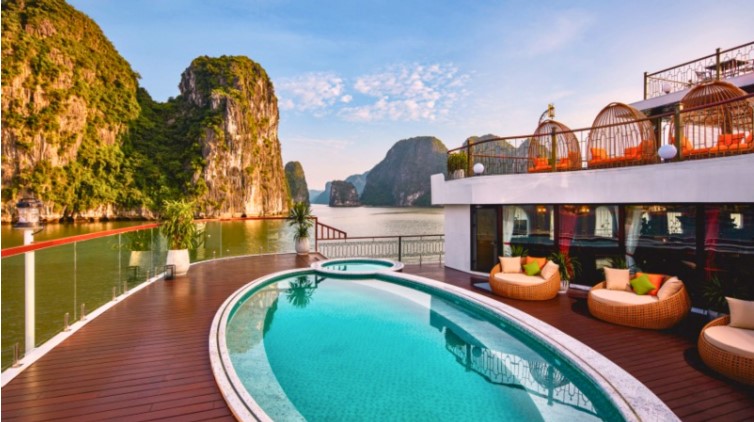

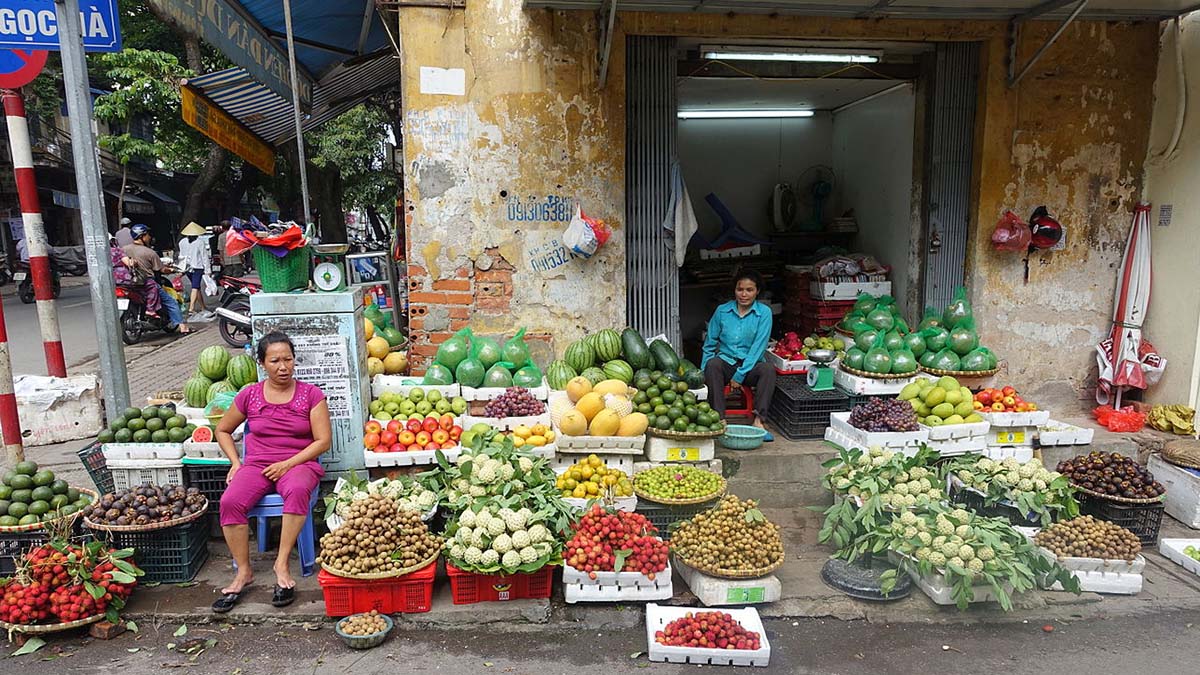


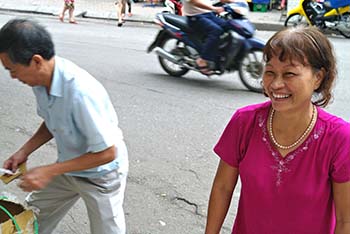

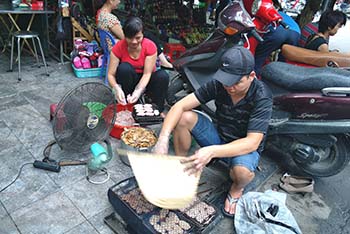
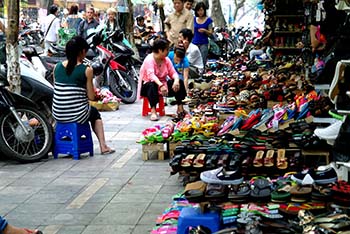
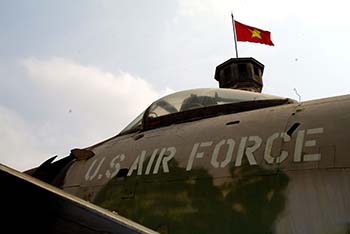



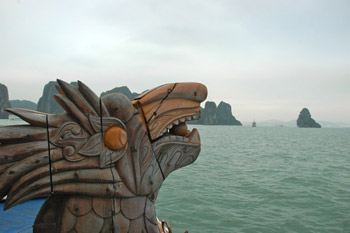 by Anne Harrison
by Anne Harrison Yet to discover the true town, I had to be brave and run the gauntlet. Passing through the chaos I wondered if this was where the belly of the dragon had scalded the land. It certainly seems so. Or perhaps his fiery breath so scorched the earth nothing of beauty could grow.
Yet to discover the true town, I had to be brave and run the gauntlet. Passing through the chaos I wondered if this was where the belly of the dragon had scalded the land. It certainly seems so. Or perhaps his fiery breath so scorched the earth nothing of beauty could grow. Further up the hill, some half hour from the port, a tiny laneway opened onto the local market, which had been somehow hidden from view despite its size. Once inside it felt totally chaotic, but with a mood completely opposite to the turmoil down by the water. With the stalls run largely by women (for the men are down by the port, scamming tourists), the place is roughly divided into sections: clothes, hardware, household items, fresh fruit and vegetables, then a wet market which stretches forever. The range of seafood is incredible – and largely unrecognizable.
Further up the hill, some half hour from the port, a tiny laneway opened onto the local market, which had been somehow hidden from view despite its size. Once inside it felt totally chaotic, but with a mood completely opposite to the turmoil down by the water. With the stalls run largely by women (for the men are down by the port, scamming tourists), the place is roughly divided into sections: clothes, hardware, household items, fresh fruit and vegetables, then a wet market which stretches forever. The range of seafood is incredible – and largely unrecognizable.
 Nourished and refreshed, we headed back to the water. After all, this is why people come to Halong Bay. The afternoon began in a whirl of noise exploring the islands on a boat about the size of the African Queen, and about as sea-worthy. A trip amongst the islands is a rather crowded affair, but by now I had adapted to the chaos. Standing on the bow, I enjoyed the spectacle as our boat assumed ramming speed to gain prime position at any mooring. With all the boats covered with old tires, the moorings resound to the thuds of collisions, and the creak of wood as the boats jostled among themselves.
Nourished and refreshed, we headed back to the water. After all, this is why people come to Halong Bay. The afternoon began in a whirl of noise exploring the islands on a boat about the size of the African Queen, and about as sea-worthy. A trip amongst the islands is a rather crowded affair, but by now I had adapted to the chaos. Standing on the bow, I enjoyed the spectacle as our boat assumed ramming speed to gain prime position at any mooring. With all the boats covered with old tires, the moorings resound to the thuds of collisions, and the creak of wood as the boats jostled among themselves. The first stop was Thien Cung Grotto – or Palace of Heaven. After climbing some 100 steps, a crowd of us went along a dark tunnel to the cave proper. Some hold this is the actual cave where the dragon sought refuge. It was simply huge. Neon lights of all colors highlighted the various formations: a dragon with a small man riding his back, elsewhere a pair of angel wings. Small rivulets ran down the stones and into vast chasms of nothingness. A dragon could easily live here – as could dwarves or a horde of orcs. There was a perfect cave for Gollum.
The first stop was Thien Cung Grotto – or Palace of Heaven. After climbing some 100 steps, a crowd of us went along a dark tunnel to the cave proper. Some hold this is the actual cave where the dragon sought refuge. It was simply huge. Neon lights of all colors highlighted the various formations: a dragon with a small man riding his back, elsewhere a pair of angel wings. Small rivulets ran down the stones and into vast chasms of nothingness. A dragon could easily live here – as could dwarves or a horde of orcs. There was a perfect cave for Gollum. I sat in the bow of our boat as it potted among the islands. Each one, it seems, has a name such as Island of The Two Hens or Tea Pot Island. Many caves open straight onto the water as the islands rise straight form the sea to tower over everything, their tops covered with lush vegetation. The Surprise Cave was not discovered until 1901, and was used by the Viet Cong as a hide-out. At Ba Hung Cave, featured in the movie Indochine, a small grotto opens onto a lagoon inside the island, surrounded by walls of steep jungle.
I sat in the bow of our boat as it potted among the islands. Each one, it seems, has a name such as Island of The Two Hens or Tea Pot Island. Many caves open straight onto the water as the islands rise straight form the sea to tower over everything, their tops covered with lush vegetation. The Surprise Cave was not discovered until 1901, and was used by the Viet Cong as a hide-out. At Ba Hung Cave, featured in the movie Indochine, a small grotto opens onto a lagoon inside the island, surrounded by walls of steep jungle.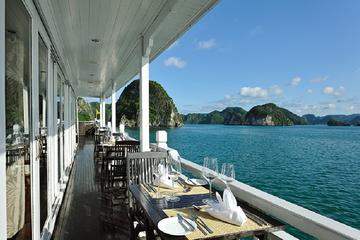
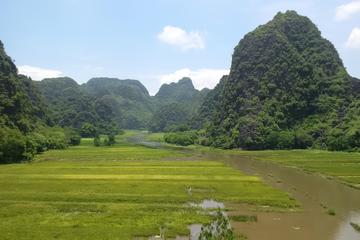

 After dinner I sat and waited for Pyle in my room over the Catinat.”
After dinner I sat and waited for Pyle in my room over the Catinat.” Further along Duong Dong Khoi stands the Rex Hotel. Here the rooftop bar (complete with elephants) overlooks the heart of Saigon; perhaps this is why a bottle of champagne here comes with six waiters. The heavens of the wet season opened just as we sat down, so for an hour or so we had the place – plus waiters – to ourselves. After beginning life as a French garage, during the Vietnam War the Rex Hotel became home to the Press Corps, and probably the CIA. Now it is owned by the Communist Party.
Further along Duong Dong Khoi stands the Rex Hotel. Here the rooftop bar (complete with elephants) overlooks the heart of Saigon; perhaps this is why a bottle of champagne here comes with six waiters. The heavens of the wet season opened just as we sat down, so for an hour or so we had the place – plus waiters – to ourselves. After beginning life as a French garage, during the Vietnam War the Rex Hotel became home to the Press Corps, and probably the CIA. Now it is owned by the Communist Party. I had seen him last September coming across the square towards the bar of the Continental.”
I had seen him last September coming across the square towards the bar of the Continental.”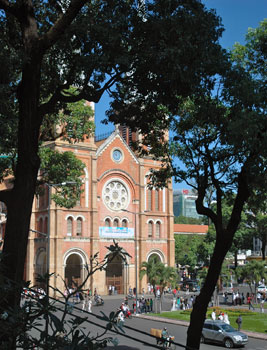 A few tree-lined blocks to the north of the Rex Hotel, the Cathedral Notre Dame and the Central Post Office face one another across a small square. Although Fowler was dismissive of the style, the cathedral is quite delightful, with each stone shipped from Marseilles, and the stained glass from Chartres.
A few tree-lined blocks to the north of the Rex Hotel, the Cathedral Notre Dame and the Central Post Office face one another across a small square. Although Fowler was dismissive of the style, the cathedral is quite delightful, with each stone shipped from Marseilles, and the stained glass from Chartres.
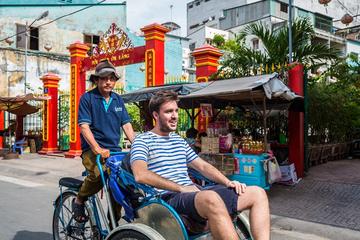
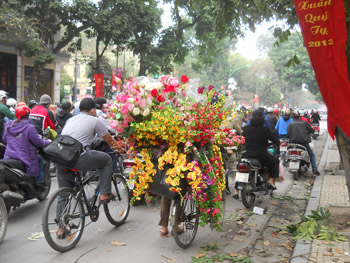
 Hanoi is a contrast of old and new with some intriguing contradictions. The National Museum is housed in an old colonial building. The 900 year old Temple of Literature was a center of Confucian learning and thought. The French-era Opera House is beautifully appointed … and located opposite the Hanoi stock exchange in a square that includes a Gucci store and the Hanoi Hilton, that’s the hotel, not the prison which is across town.
Hanoi is a contrast of old and new with some intriguing contradictions. The National Museum is housed in an old colonial building. The 900 year old Temple of Literature was a center of Confucian learning and thought. The French-era Opera House is beautifully appointed … and located opposite the Hanoi stock exchange in a square that includes a Gucci store and the Hanoi Hilton, that’s the hotel, not the prison which is across town. But Hanoi’s Old Quarter is a source of wonder too – vibrant, vigorous, visceral. Delicious pho (pronounced “fa”) dished up in noodle soup restaurants. Egg coffee served on a balcony overlooking Hoan Kiem Lake. Sidewalk food stalls, bakeries, bars and coffeehouses proliferate. The narrow streets are packed with mini hotels and hostels, family shops, crafts and trades, and small businesses – the never-ending hustle of street life.
But Hanoi’s Old Quarter is a source of wonder too – vibrant, vigorous, visceral. Delicious pho (pronounced “fa”) dished up in noodle soup restaurants. Egg coffee served on a balcony overlooking Hoan Kiem Lake. Sidewalk food stalls, bakeries, bars and coffeehouses proliferate. The narrow streets are packed with mini hotels and hostels, family shops, crafts and trades, and small businesses – the never-ending hustle of street life. I’ve been curious about the impact of the “Vietnam War” on this country. Vietnamese history cites many wars, not just the one we talk about. There are earlier wars against the Chinese and the Mongols, conflicts between the Nguyen lords of the north and the Champa kingdom of the south, the war of independence against the French (aka First Indochina War), the civil war (aka Second Indochina War or American War) between north and south divided politically by the 1954 Geneva convention and geographically by the 17th parallel, and most recently the 1980’s war against the Khmer Rouge in Cambodia.
I’ve been curious about the impact of the “Vietnam War” on this country. Vietnamese history cites many wars, not just the one we talk about. There are earlier wars against the Chinese and the Mongols, conflicts between the Nguyen lords of the north and the Champa kingdom of the south, the war of independence against the French (aka First Indochina War), the civil war (aka Second Indochina War or American War) between north and south divided politically by the 1954 Geneva convention and geographically by the 17th parallel, and most recently the 1980’s war against the Khmer Rouge in Cambodia.
 Reminders of the civil war can be found everywhere. In Hanoi, they are present in all the museums. In Hue, capital of the Nguyen Dynasty, a large national flag flies from the Citadel which dominates the Imperial City and Forbidden Purple Palace. The national flag flew here for 28 days when the Viet Cong and North Vietnamese Army captured the Citadel during the 1968 Tet offensive.
Reminders of the civil war can be found everywhere. In Hanoi, they are present in all the museums. In Hue, capital of the Nguyen Dynasty, a large national flag flies from the Citadel which dominates the Imperial City and Forbidden Purple Palace. The national flag flew here for 28 days when the Viet Cong and North Vietnamese Army captured the Citadel during the 1968 Tet offensive. Hoi An is a wonderfully historic city, and also a UNESCO World Heritage site. Night lanterns light up the streets of the old town with its Chinese clan houses, pagodas and covered bridges. I stumble upon a house that belonged to one of the early revolutionaries in the city. His grandson proudly shows me photos of grandpa with General Giap, chief architect of the French defeat at Dien Bien Phu, and of the strategy that led to the North’s victory in the civil war.
Hoi An is a wonderfully historic city, and also a UNESCO World Heritage site. Night lanterns light up the streets of the old town with its Chinese clan houses, pagodas and covered bridges. I stumble upon a house that belonged to one of the early revolutionaries in the city. His grandson proudly shows me photos of grandpa with General Giap, chief architect of the French defeat at Dien Bien Phu, and of the strategy that led to the North’s victory in the civil war. Nha Trang is a sun, sand and sea beach town. It’s predicted to grow exponentially. The Long Son pagoda is full of families praying for good fortune in the new year, and paying their respects to their ancestors. Clouds of incense carry their prayers heavenward past the enormous white Buddha atop the hill overlooking the pagoda. The Tet celebrations culminate in a spectacular fireworks display from barges off the beach. Thousands of people are out to watch, young and old. The beach is vast, and there is much construction in progress. Signs in Russian and English vie for attention.
Nha Trang is a sun, sand and sea beach town. It’s predicted to grow exponentially. The Long Son pagoda is full of families praying for good fortune in the new year, and paying their respects to their ancestors. Clouds of incense carry their prayers heavenward past the enormous white Buddha atop the hill overlooking the pagoda. The Tet celebrations culminate in a spectacular fireworks display from barges off the beach. Thousands of people are out to watch, young and old. The beach is vast, and there is much construction in progress. Signs in Russian and English vie for attention.